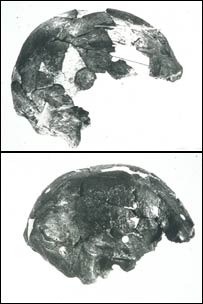The scientific magazine "Nature" reports that the latest tests done prove that Homo sapiens is 195 thousand years old, 65 thousand years older than estimated
concentration of sources

The two skulls found in the late 60s were re-dated. Strengthening the theory of African origin
Direct link to this page: https://www.hayadan.org.il/hs240205.html
Two human remains found in Ethiopia in 1967 are 195 years old - 65 years older than initially thought, scientists announced late last week. The new dating makes the skulls and bones the earliest remains of Homo sapiens found so far.
The fossils were found 38 years ago near the Omo River in southern Ethiopia by a research team led by anthropologist Richard Leakey. Dating revealed that they are 130 thousand years old, although many researchers, including the scientists who discovered the fossils, were not sure that this was indeed their true age. At that time, scientists thought that it was unlikely that modern humans would be more than a hundred thousand years old.
Two years ago, scientists announced that they had discovered fossils of Homo sapiens that were 160 years old in northeastern Ethiopia. Dr. Tim White of the University of California at Berkeley and his colleagues determined that the skulls of two adults and a child "probably anatomically represent the ancestors of modern humans." At the same time, genetic research done in recent years indicated that the first modern humans lived 150 to 200 years ago.
The new dating of the findings from '67, conducted with more reliable methods than those previously used, was done by a research team led by Dr. Ian MacDougall from the Australian National University in Canberra and was described last weekend in the journal "Nature". It reinforces the theory that modern humans originated in Africa, and the earlier date gives Homo sapiens a longer stay during which it could have developed the traits that likely helped it spread from Africa to Asia and Europe.
Although other scientists accepted the new dating, the debate continues about the nature of the two fossils, which belong to humans who lived several hundred years apart. The skulls and bones designated "Omo 1" are modern in almost every possible sense. However, "Omo 2", a partial skull without body bones, looks a bit primitive compared to other early Homo sapiens fossils.
The scientific magazine "Nature" reports that the latest tests done prove that Homo sapiens, the modern man, is 195 thousand years old, 35 thousand years older than what has been estimated so far. The new determination was made based on a find discovered back in 1967 in the Kibish region of Ethiopia - two human skulls and skeleton bones were nicknamed "Homo-1" and "Homo-2".
The researchers led by Richard Leakey, Prof. Frank Brown from the University of Utah in the United States and Prof. Ian MacDougall from the University of Sydney, emphasized that in their estimation "humanity, as we know it today, probably did not begin until 50 thousand years ago". They added: "Regarding that ancient Homo sapiens, we have no evidence that he even ate fish or used the tools he made for himself."
For news at the BBC
They knew the rise of man
https://www.hayadan.org.il/BuildaGate4/general2/data_card.php?Cat=~~~1164263~~~51&SiteName=hayadan
